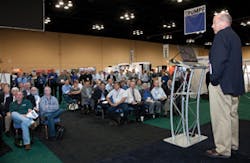LME 2012 expands educational offerings
Geoff Giordano
By popular demand, new tutorials on welding, joining, and ultrafast laser processes
The Laser Institute of America (LIA), organizer of the Lasers for Manufacturing Event (LME), is taking a bold leap forward in its second year, inviting exhibitors to bring working laser systems to the unique one-stop showcase for laser-based production. Building on the momentum and overwhelmingly positive feedback of the inaugural event held in 2011 in Schaumburg, IL, LME will return to the Renaissance Schaumburg Convention Center Hotel bigger and bolder on Oct. 23-24. LME 2012 will feature more basic courses and a pair of two-hour tutorials addressing welding and joining, and ultrafast laser processes.
Education at LME
The LIA is expanding the educational track at this year’s LME 2012, providing attendees vital guidance on how to create effective and efficient laser-based production systems to increase profitability in a broad range of applications, predominantly aerospace, automotive and medical. Three new courses addressing the fundamentals of laser additive manufacturing, cutting, and robotics have been added, along with two tutorials. These will appear alongside primer sessions on the main types of lasers used for manufacturing, creating laser systems, and establishing return-on-investment.
A new two-day Laser Welding & Joining Workshop, chaired by LIA past president and Schawlow award winner Prof. Eckhard Beyer of Fraunhofer IWS, will run concurrently with LME, featuring 18 presentations spread out over two days to address lasers from the basics to high-end applications. Industrial research experts will present short courses giving overviews of laser basics and current developments, while end users with longstanding experience will present their solutions to typical challenges of laser applications, including power-train welding, remote welding, hybrid welding, and “micro” applications.
“We still see a big impact of the tremendous rise in beam quality and energy efficiency,” noted Beyer. “Here the application fields are expanded in many ways: ultralow distortions, or the realization of new mixed-material joints such as copper-aluminum using precisely shaped weld pools. Also, remote-beam applications are now standard; that field was restricted to expensive high-brightness lasers just a few years ago. Furthermore, laser size reduction is a key development; many lasers are now so small that machine integration is much simpler and can be done in a way not possible before.”
Focus on ultrafast lasers
Although slated as a tutorial this year, the program on ultrafast lasers could grow into another two-day workshop next year. For the inaugural session, LIA president Prof. Reinhart Poprawe of Fraunhofer ILT says the educational track will feature technical examples, a survey of Technology Readiness Level (TRL) 1-9 materials, and an overview of markets and materials. The session will be geared to those involved with optical systems and scanning technologies, as well as users of precision machining applications with accuracy in the range of ≤10 µm.
“The development of ultrafast lasers with pulse durations of some 100 femtoseconds to 10 picoseconds on an industrial scale with powers up to the kilowatt class, has led to a new level of laser processing with ultimate processing quality,” Poprawe explained. “Starting with physical basics on ultrashort-pulse interaction phenomena, the tutorial will give a survey on different applications from electronics, energy topics, and tooling technology to large-area processing for tribology optimization and surface functionalization.” The tutorial is particularly suited for engineers and scientists from machine suppliers and end-users, and manufacturers of ultrafast lasers and optical systems (scanning technologies) will learn about the requirements of system technology with respect to laser parameters and processing parameters.
“Ultrashort-pulsed lasers are heading to the edge of mass industrialization and will undergo similar growth rates like other lasers in the past,” Poprawe asserted. Ultrafast lasers are being applied in the biomedical, automotive, and tool and molding industries; LED and OLED light-guiding systems; photovoltaics and energy storage; and general surface processing. The tutorial will help shed some light on current debate over what kind of pulse lengths are optimal for what materials, how best to apply high-repetition lasers to workpieces, and how researchers and manufacturers can concentrate on shortening manufacturing cycle times.
Safety education
In addition to spotlighting the bottom-line benefits of lasers, LME 2012 will put the need for laser safety front and center. LIA education director Gus Anibarro, the event’s Laser Safety Officer (LSO), will again give a one-hour presentation on assessing beam and nonbeam hazards in the laser manufacturing environment and how to ensure the safety of operating personnel. This crash course in proper laser use will cover the classes of lasers, direct vs. reflected exposure, the need to control laser-generated air contaminants, skin and eye hazards, and how to choose eyewear of the proper optical density. [This information-packed session highlights prevention rudiments addressed more fully in LIA’s two-, three- and five-day laser safety courses; view the LIA’s full range of laser-safety courses and online resources at www.lia.org/education/online.]
Networking made easy
LME 2012, held in proximity to a large number of manufacturers and job shops, is an all-in-one experience for those seeking to refine current laser systems and applications, or assessing potential new ways to employ lasers in production. While the educational program provides tools to help assess the benefit of investing in lasers, the exhibit floor provides a real-time marketplace to discuss applications and primary and ancillary equipment with top-tier suppliers.
Toward that end, LME will again feature the highly popular Laser Technology Showcase, a stage at the front of the exhibit hall that will be used for keynote educational presentations and shorter informational addresses by many companies in attendance. The showcase format helped foster interaction between attendees seeking solutions and a wide array of industry leaders able to lend their expertise in person.
To learn more about or register to attend LME 2012, visit www.laserevent.org. ✺
Geoff Giordano is a freelance writer for the LIA.
More Industrial Laser Solutions Current Issue Articles
More Industrial Laser Solutions Archives Issue Articles



